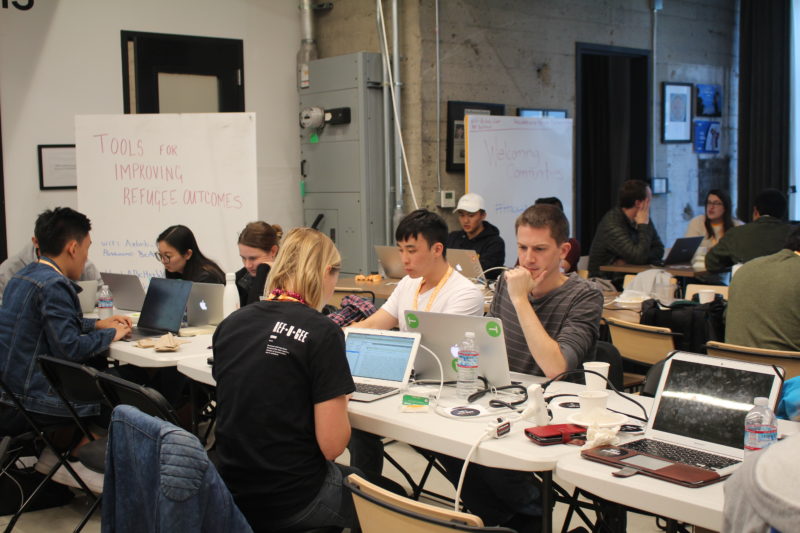- Using DigitalGlobe’s GBDX Notebooks and tagged tents from this year’s Tomnod campaign, participants created maps visualizing the distance between boreholes (places where well water pumps are installed) and shelters in refugee camps in Africa. Participants accomplished the following goals using geospatial tools: (1) identified tents based on their distance from boreholes, (2) outlined the overloaded boreholes and (3) a planning tool for borehole failure.
 Boyabu refugee camp, Democratic Republic of Congo, mapping boreholes and trees.[/caption]
Boyabu refugee camp, Democratic Republic of Congo, mapping boreholes and trees.[/caption]
- Combining data from Twitter and news media, USA for UNHCR learned about the sentiment toward refugees from the general U.S. population as well as politicians, celebrities, international agencies and newspapers. Participants built tools that will allow USA for UNHCR to initiate new conversations around refugees and to raise awareness and support for refugees.
- Drawing upon a unique survey of public school teachers, refugee statistics and DonorsChoose.org donations data, participants proposed interventions to support resettled refugees and educators that serve them in public schools across the U.S.
- Compiling census data, statistics from the Office of Refugee Resettlement and the Refugee Processing Center, participants completed an exploratory data analysis to identify communities that are welcoming to and supportive of refugees at the city and state level. Additionally, due to participant interest in volunteering with resettled refugees after the event, several software engineers built a website prototype that will connect individuals with refugees.
 Volunteers analyzing the data.[/caption]
Maxar’s DigitalGlobe supported this data for good event because we are committed to supporting the humanitarian community and fulfilling Maxar’s purpose of Building a Better World.
If you are interested in volunteering with the data for good community as a Data Science Volunteer at USA for UNHCR, please complete this survey or contact Nicole Smith, nicole@unrefugees.org.
To see more on #HackABetterWorld, check out the stories on Instagram, @usaforunhcr.
Volunteers analyzing the data.[/caption]
Maxar’s DigitalGlobe supported this data for good event because we are committed to supporting the humanitarian community and fulfilling Maxar’s purpose of Building a Better World.
If you are interested in volunteering with the data for good community as a Data Science Volunteer at USA for UNHCR, please complete this survey or contact Nicole Smith, nicole@unrefugees.org.
To see more on #HackABetterWorld, check out the stories on Instagram, @usaforunhcr.